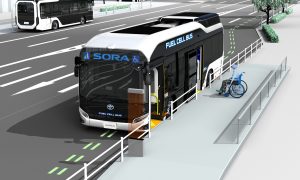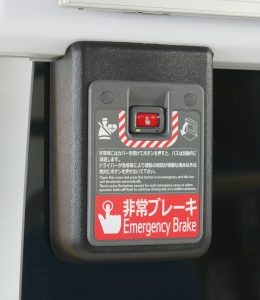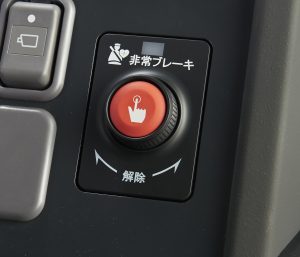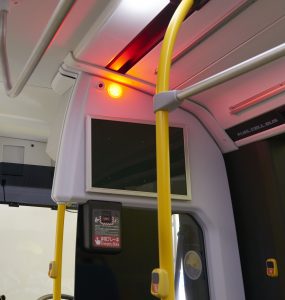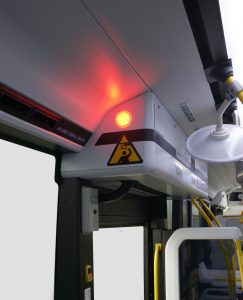Toyota Equips Sora Hydrogen Fuel Cell Electric Bus with Preventive Safety Features
Sora1, Toyota’s hydrogen fuel cell electric bus, has been upgraded with a series of safety features designed to help prevent accidents and enable smooth, punctual running. The new systems2 make use of the vehicle’s ITS (Intelligent Transport System) functions, communicating with other vehicles and roadside infrastructure.
Sora went into production last summer and more than 100 are expected to be on the road, mainly in the Tokyo metropolitan area, in time for the 2020 Tokyo Olympics and Paralympics. Powered by the Toyota Fuel Cell System, like that featured in the Mirai saloon, Sora produces no harmful emissions when driven.
As a public service vehicle, Sora requires a high operation rate and high safety performance at all times. To support this, the bus has been equipped with a function that warns the driver when making right turns at junctions and a system the passengers can use to trigger an emergency stop in urgent situations, for example if the driver is suddenly taken ill.
An intelligent system shares information on the distance between vehicles to prevent two or more buses travelling in convoy from being separated at traffic lights or bus stops. This will help improve the transportation system’s capacity and the speed and punctuality of the buses.
PREVENTIVE SAFETY FUNCTIONS
ITS vehicle-to-infrastructure communication system (DSSS Driving Safety Support Systems)
Infrastructure devices and vehicles share information on oncoming vehicles, pedestrians and traffic lights to increase driver awareness.
- Right-turn Collision Caution: when the bus is turning right at a junction, the system activates an alert to warn the driver of potential hazards, such as oncoming vehicles or pedestrians in the road.
- Red Light Caution: when the bus approaches a red light at a junction, the system activates an alert if the driver does not ease off the accelerator, or does not see the red light ahead.
- Red Light Deceleration Assist: when the vehicle is approaching a junction and stopping for a red light is likely, the system encourages early deceleration.
- Signal Change Advisory: to avoid delayed starts at traffic lights, a display shows the driver the time remaining until the lights change.
Emergency Driving Stop System (EDSS)
If an emergency occurs, for example if the driver is suddenly taken ill, the EDSS allows the driver or passengers to activate an emergency brake switch to slow the bus and bring it to a halt3. The system has been designed specifically for public transport buses, where the safety of standing passengers has to be taken into account. As the bus begins to decelerate, red flashing lights and a voice alert warn passengers of the emergency. The vehicle’s horn sounds and the stop lights and hazard lights flash to warn those outside the vehicle.
Collision Warning System
Sora is fitted with a front-mounted millimetre-wave radar which detects if there is a collision risk with a vehicle or obstacle ahead. If it determines an impact might occur, it alerts the driver with warning buzzer and activates a warning message on the interior monitor screen. The system takes into account the safety of passengers who are standing and those who have not fastened their seatbelts. It helps the driver avoid a collision by providing steering assistance.
TRANSPORTATION CAPACITY
ITS Connect Vehicle-Convoy Information Service
This system uses information about individual buses, their sequence and the distance between vehicles travelling together to prevent a convoy being separated at traffic lights or bus stops. This helps improve the capacity, speed and punctuality of the service.
- Vehicle-Convoy Recognition Function: the system uses vehicle-to-vehicle communications and millimetre-wave radar to recognise information (within the limits for maximum bus numbers in any given route section) on the individual buses, bus order and distance between buses travelling in convoy, and notifies the drivers of the convoy size. To ensure the entire convoy can pass through a set of traffic lights together, the last bus in the line sends a request to the lights to remain green for an extended time. Vehicle-to-vehicle communications and radars are used to recognise the formation of a convoy
- Bus Stop-Start Information System: this system recognises when customers board and alight from buses travelling in convoy, helping ensure the entire convoy leaves the stop at the same time.
ITS Connect Communication Radar Cruise Control
The buses are fitted with all-speed radar cruise control, which supports smooth acceleration and deceleration. If a vehicle in front is also equipped with the system, the bus uses information shared through vehicle-to-vehicle communications to respond promptly to its acceleration and deceleration, allowing smooth following. The system also helps maintain a constant distance from the vehicle ahead when travelling in convoy on dedicated bus roads4, and the stable driving speed of following vehicles.
SPEED AND PUNCTUALITY
ITS Connect Wave-Type Public Transportation Priority System with Convoy Function
This system uses dedicated ITS radio to send requests to infrastructure devices to extend green or red traffic light phases. When a convoy is operating, the last bus in the line sends a request for a longer green light phase, reducing the risk of the convoy being split by a red light.
BARRIER FREE
Automatic Arrival Control System
This optional system detects guidance lines on the road surface and automatically steers and decelerates the bus, bringing it to a halt at designated stops and minimising the gap between the vehicle and bus stop. This makes it easier for people using pushchairs or wheelchairs to board or alight.
Toyota Sora principal specifications
| VEHICLE | |
| Overall length (mm) | 10,525 |
| Overall width (mm) | 2,490 |
| Overall height | 3,350 |
| Passenger capacity – seated | 22 |
| Passenger capacity – standing | 56 |
| Total capacity (including driver) | 79 |
| FUEL CELL STACK | |
| Type | Toyota FC Stack, solid polymer electrolyte |
| Max. output (kW/PS) | 114/155 (x2) |
| MOTOR | |
| Type | AC synchronous |
| Max. output (kW/PS) | 113/154 (x2) |
| Max. torque (Nm) | 335 (x2) |
| HIGH-PRESSURE HYDROGEN TANK | |
| Number of tanks | 10 |
| Nominal working pressure (MPa) | 70 |
| Internal volume (l) | 600 |
| DRIVE BATTERY | |
| Type | Nickel-metal hydride |
| EXTERNAL POWER SUPPLY SYSTEM5 | |
| Max. output (kW) | 9 |
| Power supply amount (kWh) | 235 |
1 Sora – the name is an acronym, Sky Ocean River Air, representing the earth’s water cycle.
2 Among newly added functions, Emergency Driving Stop System, Collision Warning System, Automatic Arrival Control, ITS Connect Vehicle-to-Infrastructure Communication System, and ITS Connect Communicating Radar Cruise Control were jointly developed by Hino Motors Limited. and Isuzu Motors Limited. Vehicle-Convoy Information Service and ITS Connect Wave-Type Public Transportation Priority System with Vehicle Convoy Recognition Function were jointly developed by these two companies and Toyota.
3 This system conforms to the Ministry of Land, Infrastructure, Transport and Tourism’s “Emergency Driving Stop System” technological guidelines.
4 Dedicated bus roads are for the use of public transport buses only, and other types of vehicles are prohibited from using them. Dedicated bus roads differ from standard bus lanes, which other types of vehicles are prohibited from using by law, except when making right or left turns.
5 The power that can be supplied and the amount of power may differ, depending on the performance of the power supply unit, amount of hydrogen remaining and power consumption. The external power output device is sold separately.
ENDS

